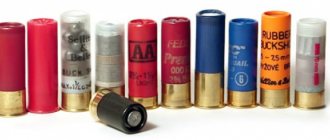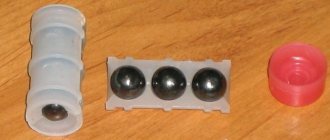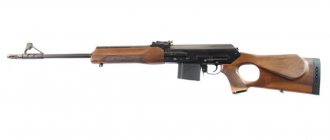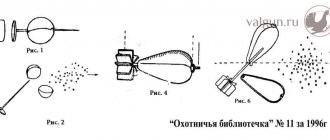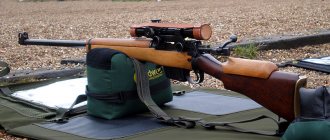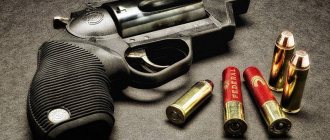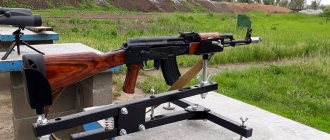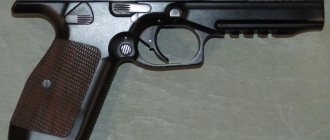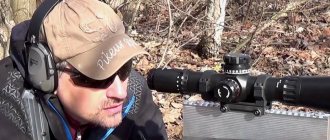How many cartridges are in zinc 5.45 39. Live journal of Andrey Stadnik. Commercial Ammo Packaging
In the Soviet armed forces, the packaging of cartridges is carried out according to the standard system: box-zinc-pack. The main element of the closure is a hermetically sealed metal box (in common parlance - “cartridge zinc”). In ancient times, boxes made of galvanized iron (sealed) were actually used, but in the 1960s they were abandoned in favor of welded iron ones, painted with protective enamel (index 57-Я-004 and 57-Я-004Ш, used until mid-1970 's), and then solidly stamped. Modern cartridge zincs (index 57-Я-0461) are stamped from low-carbon steel and enameled. Dimensions: 357x156x103 mm, weight 0.9 kg. This type of box is the same for all calibers of small arms, but the number of cartridges held varies. Americans call such cartridge boxes “spam cans” (“tin cans”).
Opened box, zinc and a pack of 7.62 mm cartridges. 1943 with PS bullets produced by the Klimovsky Stamping Plant
Wooden boxes act as transport and storage (external) containers. Each box holds two zincs. Cartridge boxes are made from softwood lumber, except for the bottom and lid, which are made from fiberboard. The lid of the box is hinged and attached to its body using metal fittings. In addition, the box has two wooden handles for carrying. Until 1979, cartridge boxes were made entirely, including the bottom and lid, of wood with the lid attached to the body of the box with screws.
The dimensions of a standard cartridge box (index 57-Ya-005) are 488x350x163 mm, the weight of an empty box varies between 3.6-4.0 kg. The difference between the gross and net weight of the box (the total weight of the cartridges contained) is approximately 7 kg. In addition to the metal boxes with cartridges themselves, a special knife is also placed in the box for opening them. In boxes with a lid made of fiberboard, the knife is placed in a slot on the inside of the end wall of the box, and with a lid made of wood - in the corresponding slot on the inside of the lid. The sealed cartridge box is tightly covered (tied) with steel packing tape. The ends of the tape are connected mechanically with sealing or welding.
1 — boxes of 7.62 mm cartridges. 1943 with PS bullets, old version with a plank cover;
2 — a box of 7.62 mm rifle cartridges with LPS bullets, old, used before 1990, variant marking on the lid (gross weight and transport sign - number “2” in a triangle);
3 — box of cartridges 5.45 PS (7N6);
4 — box of 7.62 PS (7N1) cartridges, export markings on the lid.
Internal containers are cardboard boxes or paper bags with cartridges (in the text of the article they will also be called “packs”, not to be confused with a “pack”, that is, a “clip for pack loading” for a Garand rifle), placed in a metal box. For ease of removal from zinc, a fabric tape is placed under one of the packs of each row, the ends of which are brought to the surface. Marking of cartridge containers consists of inscriptions, signs and colored distinctive stripes; applied by stenciling, stamping, printing or a special marking machine.
Now specifically about calibers. Military ammunition 7.62x54 mm R is packaged in packs with a capacity of 20 rounds. For a long time, unpainted cardboard was used as pack material. Later, waxed paper rolls, stapled at the sides, were also used. Zinc holds 22 packs, for a total of 440 rounds. Opening zinc with cartridges using the supplied knife
Packs of 7.62 PS (7N1) cartridges, cardboard (left) and paper
High-precision 7.62 PS (7N1) cartridges have a distinctive inscription “Sniper” on the packaging, and 7.62 SNB cartridges ( 7N14) - the inscription “Sniper” and a black stripe. Until 1977, 7.62 LPS (57-N-223S) cartridges were marked with a white stripe on the cartridge container, and the bullet nose was also painted white, but later this color marking was no longer used.
For weapon ammunition of 7.62x39 mm caliber, designated in the Soviet army as the “7.62 mm cartridge of the 1943 model”, the manuals for small arms indicate two standard closure options: for the Kalashnikov assault rifle - in cardboard boxes of 20 pieces, 33 boxes in zinc, a total of 660 rounds; and for the SKS carbine - in clips of 10 rounds, two loaded clips are placed in a flat oblong cardboard box, in zinc there are 23 boxes, for a total of 460 rounds.
Old galvanized cartridge box for 7.62 mm cartridges mod. 1943 with BZ bullets. Above - close-up of the markings on the box lid
Metal boxes with cartridges of 7.62×39 mm caliber: 1 - armor-piercing 7.62 BP;
2 - with a subsonic bullet 7.62 US; 3, 4 - commercial with a jacketed bullet with a lead core.
However, the actual zinc capacity of this caliber ammunition varies. The most common figures: 700 shell 7.62 PS gzh, 720 armor-piercing 7.62 BP and 640 commercial sporting and hunting cartridges. The explanation seems to be that the zinc capacity (660 rounds) given in the NSD for the Kalashnikov assault rifle is correct for the old galvanized box (57-Ya-002) and the corresponding cardboard pack from the 1950s, while the dimensions of modern containers are steel somewhat different. The distinctive marking of 7.62 BP armor-piercing cartridges (7N23) is a black stripe on the packaging, and 7.62 US cartridges with a subsonic bullet (57-N-231U) are a black and green stripe. The abbreviation “LCB” on export zinc with sporting and hunting cartridges stands for “lead core bullet” (bullet with a lead core), since bullets with a steel core are prohibited for hunting in some jurisdictions, and in some even for civilian use.
Packaging of 7.62 mm cartridges of the 1943 model
in clips for the SKS carbine
Cardboard packs for 20 cartridges of 7.62x39 mm of different years of manufacture. Left - 1950s (for 660-round galvanized metal box), center and right - 1960s and 1970/80s (for 700-round stamped metal boxes)
The packaging capacity of 5.45x39 mm cartridges was immediately made a multiple of the capacity of a standard machine gun magazine - 30 rounds. Initially, cartridges were packaged in cardboard boxes, but in the mid-1970s they switched to simplified paper wrapping, secured with staples. A metal box contains 36 packs with a total of 1080 rounds. An unusual feature is the deviation from the standard marking scheme for small arms ammunition that took place for this caliber until 1982: on all types of cartridge containers, the designation of the type of cartridge case was applied before the designation of the type of bullet, and not after. For example, for cartridges 5.45 PS (7N6) - “5.45 gs PS”; starting in 1982, markings began to be written in the standard order “5.45 PS gs”.
1 — box of live ammunition of 9x18 mm PM caliber; 2 - boxes of commercial cartridges of the same caliber; 3 — a box of commercial 9x18 mm PM cartridges with an expansive bullet produced by the Novosibirsk Cartridge Plant; 4 — box of live ammunition 9x19 mm PS (7N21).
Cartridges for the 9x18 mm Makarov pistol are packaged in cardboard boxes of 16 rounds each, which corresponds to the capacity of two pistol magazines. The zinc holds 80 of these boxes, for a total of 1260 rounds. The box of 9x19 mm PS (7N21) cartridges intended for the Yarygin pistol has a rather unusual oblong shape. It holds 34 cartridges, 32 such boxes fit into the zinc.
Summary data on the capacity of cartridge containers of various calibers are given in Table 1:
Table 1
Notes:
1. Data is valid for cartridge containers of the 1950s.
2. Each zinc with 7.62 US cartridges contains three spare seals for the silencer.
3. Modern closure of cartridges 7.62x39 mm PS.
4. In the game, due to the lack of photographs of such a pack, a 20-round box of 7.62x39 mm BP cartridges is implemented.
5. LCB - a sporting and hunting cartridge with a bullet with a lead core.
Markings on packaging with cartridges are applied: on a wooden box - on the lid and on one side wall; on a metal box - on the lid; on a moisture-proof bag on the longitudinal sides of the bag; on a cardboard box or paper bag - on one side of the box or bag. Example of markings on a zinc cap (7.62 LPS cartridges):
7.62 LPS gzh (7.62 - cartridge caliber, LPS - light bullet with a steel core, GZh - bimetallic sleeve), L54-77-188 (L54 - batch number, 77 - year of batch production, 188 - plant number (Novosibirsk low-voltage equipment plant)), VT92/77S (VT - brand of gunpowder (rifle powder for a heavy bullet); 92 - batch of gunpowder, 77 - year of manufacture of gunpowder, C - gunpowder manufacturer), 440 pcs. — number of cartridges in zinc.
The markings on the side of the box contain similar elements. The lid indicates the gross weight, the conventional number of the dangerous cargo in an equilateral triangle (for most types of cartridges these are the numbers “450”, for cartridges with an MDZ bullet - “263”, for blanks - “471”) and the classification code for the transport danger of the cargo “1.4 S” "(code "1.4" according to GOST 19433-88 means "Explosive materials that do not pose a significant danger"). The danger sign on an orange paper label, characteristic of foreign cartridge packaging, is used only for 12.7- and 14.5-mm cartridges with an MDZ bullet. Until 1990, the stencil on the lid of the box had a slightly different appearance - the gross weight and a transport sign indicating the category of cargo were indicated (the number “2” in a triangle).
Marking on the cover of the cartridge box
For grenade launcher shots to the under-barrel grenade launcher, packaging elements that are similar, but differ in design and size, are used. Three welded metal boxes containing 28 VOG-25 rounds each are placed in a wooden box. In boxes, shots are placed in cylindrical paper cartridges in a horizontal position with alternating directions. The density of the shots is ensured by cardboard spacers. There are a total of 84 shots in the box. The same box holds 35 VOG-25P grenade launcher rounds with the rounds arranged vertically, lined with cardboard; accordingly, a total of 105 shots are obtained in the box. One of the three boxes is tied with twine for easy removal from the box. Inside each box there are liners to ensure the safety of the shots during transportation and opening the boxes with a knife. A box opener wrapped in paper is placed in a box. The box lid is attached to the body on two hinges and secured with two locks.
For machine gun cartridges of caliber 7.62x39 mm and 5.45x39 mm with varnished steel sleeves, along with metal boxes, there is an alternative packaging method - in special moisture-proof bags, 120 pieces each. These bags are made of waterproof paper, coated on the outside with polyethylene terephthalate (lavsan) film, and on the inside, facing the cartridges, coated with a paraffin-polyisobutylene mixture. Inside the moisture-proof bag, cartridge packs are placed in one or two rows, lined with wrapping paper around the perimeter of the bag. The waterproof bag is sealed by welding the seams and bending the valves. In this case, the same wooden box is used as a transport and storage container, the internal surfaces of which are lined with waterproof paper coated on both sides or one side with a paraffin-polyisobutylene mixture.
Waterproof packs of 120 rounds of 5.45×39 mm caliber
And for the AK-74, in order to facilitate and speed up the process of loading a magazine, steel clips (so-called “combs”) for 15 rounds with an attached adapter - a loading accelerator (“spoon”) were introduced. The solution was “sniffed out” by the Americans, who have been using similar loading accelerators for the M14 and M16 for many years. Later, similar kits appeared for weapons of other calibers, including for the VSS silent rifle complex - 10 rounds of 9x39 mm caliber in a clip.
Kit for quickly loading AK-74 assault rifle magazines and packs of 5.45x39 mm cartridges
9x39 mm ammunition:
1 - loaded magazine and clip of armor-piercing cartridges with an adapter - loading accelerator;
2 — boxes with SP-5 cartridges;
3 - boxes with SP-5 (far left), SP-6 and PAB-9 cartridges.
A few words about expiration dates. According to the regulations of the former USSR, the storage period for small arms ammunition in central warehouses - in zinc and capping - is 20 years, after which they are distributed among departments for destruction (shot). Law enforcement agencies store them for 10 years, after which the cartridges must be replaced with new ones, and these are shot. Unpacked cartridges are stored for 4 years, after which they are subject to destruction (shot). I don’t presume to judge whether and how strictly these standards have always been observed and how things stand now, but I think that even with an optimistic approach, the period within which the cartridge, although no longer fully consistent in its parameters with the new product, is, with some reservations, suitable for use must not exceed 40 years. However, on weapons forums there are stories about shooting from a TT pistol with cartridges produced in 1938 and about the amazing accuracy of rifle cartridges produced in 1963, which cannot be compared with modern commercial products. Alexey Potapov in his book “The Art of the Sniper” calls the shelf life of rifle cartridges in galvanized form 70-80 years realistic, without losing their combat qualities. On the other hand, there are many cases of injuries to shooters and damage to weapons due to the use of expired ammunition... For cartridges for hunting rifled weapons, GOST 23128-78 establishes an expiration date (within which the cartridges retain all the parameters established by GOST and the probability of trouble-free operation is not less than 99.7%) in sealed packaging - 10 years, in non-sealed packaging - 2 years.
Na..) Don’t worry..) Everything has been calculated here..)
Zinc - a rolled tin box, approx. 35 cm and width approx. 15 cm, painted with protective paint. The sizes of zinc for many cartridges are the same, only the number of cartridges in zinc changes. For example, 7.62 mm rifle-machine guns, 7.62 and 5.45 machine guns, 5.45 PSM and 9 PM are placed in “zincs” of the same size. But if there are 660 7.62 machine guns, then 5.45 machine guns are 1080 pieces, 2160 in a box. The weight of the wooden box itself is 3 kg.
7.62x39 automatic - in a box there are 2 zinc pieces of 660 each, a total of 1320, the weight of the box is about 25 kg. Cartridge weight - 16.3 g; cartridge length - 56.0 mm; average bullet weight - 7.9 g; The average weight of a powder charge is 1.6 g or 1.56 g.
7.62x39 hunting - 440 pieces in zinc 7.62x39 also come not in zinc, but in plastic bags, 120 pieces each. in the package
5.45x39 automatic - in zinc 36 packs of 30 pcs. Zinc in each - about 12 kg. Wooden box (two zinc) - about 30 kg.
7.62x51A Soviet - 220 rounds in zinc, 440 in a box
7.62x54R Cartridge weight - 22 g; bullet weight - 9.6 g; charge weight - about 3.2 g; cartridge length - 77.16 mm; bullet length - 28.6 mm; sleeve length - 54.8 mm. The cartridges are packed in cardboard packs of 20 pieces, packs of 22 pieces are packed in galvanized metal boxes. Two metal boxes are placed in a wooden cartridge box. The box contains 880 rounds. The estimated weight of the box is 25 kg.
5.45×18 - PSM 2021 pcs. in zinc
SP-5 - 580 pcs. in zinc
9x18 PM Cartridge weight 9.2-10.4 g. Cartridge length 24.48-25.0 mm. Bullet weight 5.75-6.15 g. Number of cartridges in zinc - 1280 pcs. The number of cartridges in a wooden box is 2560 pcs. The estimated weight of the box is 28 kg.
9×19 7N21 - 1088 pcs. in zinc Cartridge weight 9.6-9.8 g. Estimated zinc weight 11 kg.
9x19 Para - 50 rounds per pack, 16 packs in zinc, total 800. 800x12 grams = 10 kg, if you take into account the weight of zinc
308 Win - 20 rounds per pack, 25 packs in zinc, total 500. 500×24 grams = 12 kg. + zinc weight
223 Rem - 20 rounds per pack, 25 packs in zinc, total 500. 500×11 grams = 5.5 kg. + zinc weight
7.62x33 - (cartridges for M1 Carbine; not to be confused with cartridges for M1 Garand .30-06 Springfield (7.62x63 mm)) were packaged in cardboard packs of 50 pieces, and those in turn were packed in a wooden box of 69 pieces, total 3450 rounds in a box; box dimensions 41.5x32x12 cm, weight 51.3 kg, on the front side there is a diagonal red stripe.
11.43v23 - (.45 ACP) were packaged as follows: 100 packs of 20 rounds, 2000 in total, in an iron box, and that in a wooden box measuring 41.5x32x12, weighing 48 kg; cartridges with steel sleeve 12 packs of 50 cartridges per cardboard box, 600 in total, two boxes in a wooden box, 1200 in total, box size 40.5x25x18; another option - 10 packs of 20 or 4 of 50 in a wooden box, dimensions and weight are not indicated.
9x39 The weight of the SP5 cartridge is 32.2 g, the length of the cartridge is 56 mm, the length of the cartridge bullet is 36 mm. The bullets of SP5 cartridges do not have a distinctive color. Only on the corking cardboard boxes of 10 rounds was the inscription “Sniper” applied.
5.45x39 cartridges are packed in paper wrappers of 30 pieces, which is equal to the number of cartridges in a machine gun magazine. Packs are placed in a steel box of 36 packs with a total quantity of 1080 pieces. Two boxes are placed in a wooden box with a total of 2160 cartridges. with a knife for opening steel boxes. On the lid of the stamped box and the box there are basic designations of the ammunition contained in them: their caliber, bullet type, case material, brand of gunpowder, production date and factory code.
Explanation of the designations on the stamped-rolled box: 5.45 - cartridge caliber. PS - type of bullet (with a steel core). GS - sleeve material (steel sleeve). SF033fl - brand of gunpowder (spherical phlegmatized; 0.33 - diameter of the powder grain). 601/84B - series/year of gunpowder production. O27 - ammunition production series. 84 - year (1984) of ammunition production. 270 - manufacturer's plant code. 1080 pcs. — the total number of cartridges in the box. Until 1982, at some factories, the indication of the type of ammunition differed from the accepted symbol, which was expressed in the form of applying after the caliber the type of cartridge case (GS - steel cartridge case) and, only then, the type of bullet. Most likely, an error was made in the stencil used to apply paint to the steel box.
On the steel boxes that were packed with cartridges with special bullets (T, US, armor-piercing), the type of bullet used and the corresponding marking in the form of a distinctive stripe on the lid were indicated. Cartridges with tracer bullets were marked with a standard green stripe. As a result of long-term storage of such ammunition, decay products of the tracer composition are released in the form of gases, which gradually accumulate in the free space of the box. For the free release of gases, a hole is made in the upper right corner, closed with a rubber seal (plug). When opening such steel boxes, they first pull out the plug, releasing the gases, and then use a knife to open the box with cartridges.
Stamp-rolled boxes for 5.45x39 cartridges produced since 1975. different cartridge factories.
1,2,3 - Plant No. 3 (Ulyanovsk Cartridge Plant), 1975 - 1977. 4 - Plant No. 60 (named after Frunze), 1979. 5 - Plant No. 17 (Barnaul cartridge), 1980. 6 - Plant No. 3 (Ulyanovsk Cartridge Plant), 1984. 7 - Plant No. 60 (named after Frunze), 1989. 8 - Plant No. 270 (Lugansk cartridge plant), 1977.
Zinc - a rolled tin box, approx. 35 cm and width approx. 15 cm, painted with protective paint. The sizes of zinc for many cartridges are the same, only the number of cartridges in zinc changes. For example, 7.62 mm rifle-machine guns, 7.62 and 5.45 machine guns, 5.45 PSM and 9 PM are placed in “zincs” of the same size. But if there are 660 7.62 machine guns, then 5.45 machine guns are 1080 pieces, 2160 in a box. The weight of the wooden box itself is 3 kg. 7.62x39 automatic - in a box there are 2 zinc pieces of 660 each, a total of 1320, the weight of the box is about 25 kg. Cartridge weight - 16.3 g; cartridge length - 56.0 mm; average bullet weight - 7.9 g; the average weight of a powder charge is 1.6 g or 1.56 g. 7.62x39 hunting - in zinc, 440 pieces. 7.62x39 also come not in zinc, but in plastic bags, 120 pieces each. in a package 5.45x39 automatic - in zinc 36 packs of 30 pcs. Zinc in each - about 12 kg. Wooden box (two zinc) - about 30 kg. 7.62x51A Soviet - 220 rounds in zinc, 440 in a box 7.62x54R Cartridge weight - 22 g; bullet weight - 9.6 g; charge weight - about 3.2 g; cartridge length - 77.16 mm; bullet length - 28.6 mm; sleeve length - 54.8 mm. The cartridges are packed in cardboard packs of 20 pieces, packs of 22 pieces are packed in galvanized metal boxes. Two metal boxes are placed in a wooden cartridge box. The box contains 880 rounds. The estimated weight of the box is 25 kg. 5.45×18 - PSM 2021 pcs. in zinc SP-5 - 580 pcs. in zinc 9x18 PM Cartridge weight 9.2-10.4 g. Cartridge length 24.48-25.0 mm. Bullet weight 5.75-6.15 g. Number of cartridges in zinc - 1280 pcs. The number of cartridges in a wooden box is 2560 pcs. The estimated weight of the box is 28 kg. 9×19 7N21 - 1088 pcs. in zinc Cartridge weight 9.6-9.8 g. Estimated zinc weight 11 kg. 9x19 Para - 50 rounds per pack, 16 packs in zinc, total 800. 800x12 grams = 10 kg, if you take into account the weight of zinc. 308 Win - 20 rounds per pack, 25 packs in zinc, total 500. 500x24 grams = 12 kg . + weight of zinc.223 Rem - 20 rounds in a pack, 25 packs in zinc, total 500. 500×11 grams = 5.5 kg. + zinc weight 7.62x33 - (cartridges for M1 Carbine; not to be confused with cartridges for M1 Garand .30-06 Springfield (7.62x63 mm)) were packaged in cardboard packs of 50 pieces, and those, in turn, in a wooden box of 69 pcs, a total of 3450 cartridges in the box; box dimensions 41.5x32x12 cm, weight 51.3 kg, on the front side there is a diagonal red stripe. 11.43v23 - (.45 ACP) were packaged as follows: 100 packs of 20 rounds, 2000 in total, in an iron box, and that in a wooden box measuring 41.5x32x12, weighing 48 kg; cartridges with steel sleeve 12 packs of 50 cartridges per cardboard box, 600 in total, two boxes in a wooden box, 1200 in total, box size 40.5x25x18; another option - 10 packs of 20 or 4 of 50 in a wooden box, dimensions and weight are not indicated. 9x39 The weight of the SP5 cartridge is 32.2 g, the length of the cartridge is 56 mm, the length of the cartridge bullet is 36 mm. The bullets of SP5 cartridges do not have a distinctive color. Only on the corking cardboard boxes of 10 rounds was the inscription “Sniper” applied. SP6 cartridge length - 56 mm, cartridge weight - 32.0 g, bullet length 41 mm, bullet weight - 15.6 g, core weight - 10.4 g. The tip of the SP6 cartridge bullet was painted black. The sealed cardboard boxes for these cartridges were marked with a distinctive black stripe. Later, after the advent of 9-mm machine gun cartridges with the 7N12 armor-piercing bullet, the bullet tip of the SP6 cartridge began to turn blue.
Designations on the covers of stamped-rolled iron boxes of the so-called “zinc”
7.62x39 cartridges are packed in packs of 20 pcs., packs are packed in zinc of 33 packs or in stamped boxes of 35 packs. The total number of cartridges in zinc is 660 pieces, and in a stamped metal box - 700 pieces. Two zincs are placed in a wooden box along with a knife for opening zinc/stamped boxes. In 1960, it was decided to switch from a galvanized steel box to a welded-rolled steel box, as a result of which the dimensions of the box itself and its capacity changed. Cartridges in an iron brass sleeve of early releases were packaged in packs, which had a designation of the type of cartridge, caliber and number of pieces in the pack. On the zinc cover it was indicated: 7.62 PS gzh (cartridge with a steel core, iron sleeve). Later they decided not to put any markings on the packs at all. In 1952, the production of bimetallic sleeves was launched to replace iron brass sleeves, and starting from the 1960s. - varnished steel. The cartridges in a varnished steel case were designated 7.62 PS gs.
From left to right: - Cartridge with an iron brass sleeve. — Cartridge with an iron bimetallic sleeve. — A cartridge with an iron bimetallic sleeve and a varnish coating on the bullet joint and on the capsule. — Cartridge with an experienced aluminum sleeve. — Cartridge with varnished steel sleeve.
Markings on the lid of a box with tracer cartridges (T-45)
Following the created cartridge with a bullet with a steel core, a cartridge with a tracer bullet was designed. Thus, in the period from 1949 to 1951, cartridges designated T-45 were first produced in brass-plated steel sleeves, and then there was a transition to production in bimetallic varnished steel sleeves. In 1973, employees of TsNIITOCHMASH, under the leadership of designer Sabelnikov, modernized the existing cartridge with a tracer bullet.
Dug zinc cartridges 7.62 x 39
